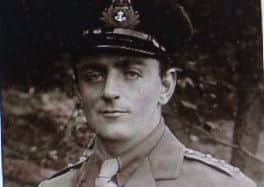NOSTALGIA: Eastbourne rugby captain who died in the Battle of the Somme


His father died when he was a baby and he and his mother moved to Eastbourne where she opened a school for girls.
He attended Tonbridge School and then went on to Pembroke College Cambridge but returned to Eastbourne and became a teacher and junior partner in a boys’ preparatory school, St Christopher’s School in the Meads district.
Advertisement
Hide AdAdvertisement
Hide AdThe building in Denton Road is now used by the University of Brighton.


Claude joined Eastbourne Rugby Club when it was reformed in 1911 and became club secretary and then captain for two years before the outbreak of the First World War.
He played in the back row.
Claude joined the Royal Naval Division, later designated the 63rd.
Sailors and recruits to the Navy who were deemed superfluous to current requirements were turned into an infantry fighting force as a result of one of Winston Churchill’s brainwaves.


Advertisement
Hide AdAdvertisement
Hide AdChurchill was at the time the First Lord of the Admiralty and as such had a seat in the Cabinet.
It was also partly his idea to open up the front in the Dardanelles.
The Royal Naval Division, however, first saw action in the Battle for Antwerp in 1914.
After the failure of this campaign the Royal Naval Division was sent to Gallipoli and took part in this disastrous venture, suffering grievous losses.
Advertisement
Hide AdAdvertisement
Hide AdAfter being evacuated from Gallipoli, many of the troops were sent into action on the Western Front.
Claude’s division, by now renamed the 63rd, was given a new commander – General Shute, a die-hard old Army officer who did not get on particularly well at first with his Navy boys.
Marching to the front on the Somme the 63rd went into action on November 13 1916 and during this first engagement lost a lot of men. It is said that only one officer and 20 men from Claude’s battalion reached the third line of their battle objectives.
Claude fell on this day and although, according to the history of St Christopher’s School, his body was never found, I was able in March this year to locate a grave in the Ancre British Cemetery where fierce fighting took place by the River Ancre near the village of Beaumont Hamel.
Advertisement
Hide AdAdvertisement
Hide AdIt is a very peaceful spot, an appropriately quiet hillside for many men to have their last resting-place.
Claude was 28.
Commanding the company next to Claude was Alfred Maynard, Cambridge Blue, Harlequin and English international hooker.
He died that day, too, and is commemorated at the Thiepval Memorial.
The 1916 Somme campaign came to an end not long afterwards.
I was able to visit Claude’s grave again on November 13 exactly 100 years to the day when he died.
Advertisement
Hide AdAdvertisement
Hide AdThere were other visitors from Britain who were also commemorating the deaths of their great uncles and other relatives. We had a lot to share. Interestingly, on the day the battle started in 1916 it was cold and misty. This time it was misty, too.
We shall remember him.
Don’t miss out on all the latest breaking news where you live.
Here are four ways you can be sure you’ll be amongst the first to know what’s going on.
1 Make our website your homepage at www.eastbourneherald.co.uk
Advertisement
Hide AdAdvertisement
Hide Ad2 Like our Facebook page at www.facebook.com/eastbourne.herald
3 Follow us on Twitter @Eastbournenews
4 Register with us by clicking on ‘sign in’ (top right corner). You can then receive our daily newsletter AND add your point of view to stories that you read here.
And do share with your family and friends - so they don’t miss out!
The Eastbourne Herald - always the first with your local news.
Be part of it.